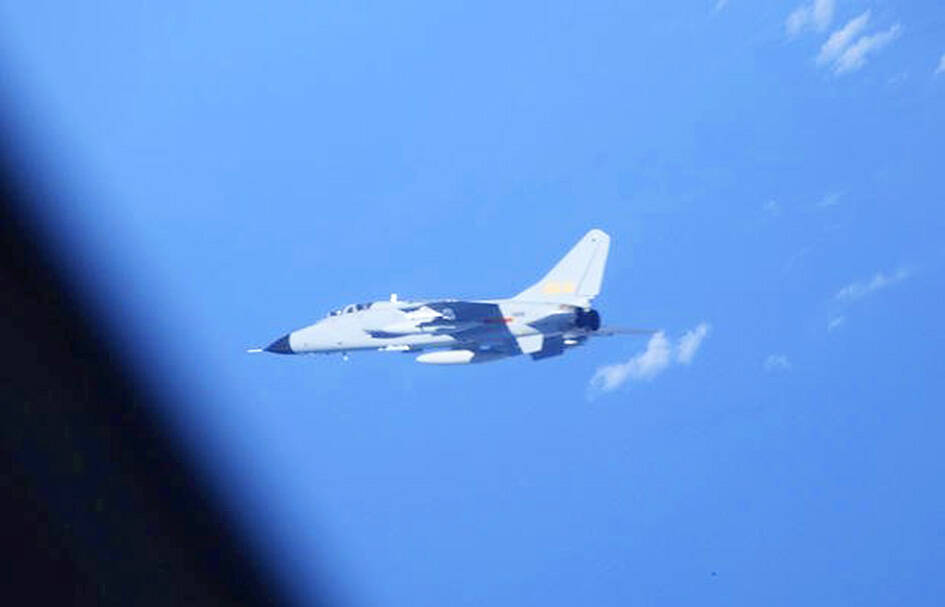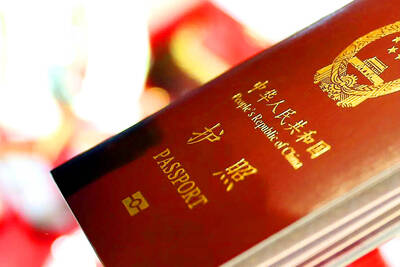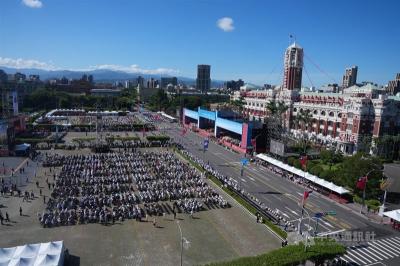Japan cautioned against China’s rapid acceleration of military activity stretching from its southwestern coasts to the Pacific, describing the moves in a new defense report released yesterday as the biggest strategic challenge.
China’s growing military cooperation with Russia also poses serious security concerns to Japan, along with increasing tension around Taiwan and threats coming from North Korea, the Japanese Ministry of Defense said in the annual report submitted to the Cabinet.
“The international society is in a new crisis era as it faces the biggest challenges since the end of World War II,” the report said, citing significant changes to the global power balance while raising concerns about an escalation of the China-US rivalry.

Photo: Japanese Ministry of Defense via AP
The security threats are concentrated in the Indo-Pacific region, where Japan is located, and could get worse in the future, it said.
Chinese Ministry of Foreign Affairs spokesman Lin Jian (林劍) said the white paper “adopts a wrongful perception of China, unjustifiably interferes in China’s internal affairs, and plays up the so-called China threat.”
Beijing has lodged protests with Japan, Lin said, defending China’s military activities as “legitimate and reasonable.”
He urged Japan to reflect on its wartime past, and “stop hyping tension in the region and China-related issues as a pretext to justify its military buildup.”
Japan has strengthened its military forces on southwestern islands in the past few years and was preparing to deploy long-
distance cruise missiles, as it worries about a conflict in Taiwan.
The presence of Chinese warships in the Pacific has steadily increased and the frequency of their passage off southwestern Japan has tripled in the past three years, including in waters between Taiwan and the Japanese island of Yonaguni, the report said.
It comes days after Japan demanded China stop flying its fighter jets unusually close to Japanese intelligence-gathering aircraft, which it said was happening repeatedly and could cause a collision.
Beijing in turn accused Japan of flying near Chinese airspace for spying purposes.
China’s increasing dispatch of aircraft carriers in the Pacific underscores the country’s attempt to advance its sea power in distant waters, the report said.
The Japanese defense ministry also noted two cases last year in which a Chinese warplane briefly violated Japanese airspace off islands near Nagasaki, and an aircraft carrier’s entry into a zone just outside of Japan’s territorial waters southwest of the Nansei island chain, which stretches from the southern coast of Kyushu to Taiwan.
North Korea poses “an increasingly serious and imminent threat,” the report added, pointing to Pyongyang’s development of missiles capable of carrying nuclear warheads and solid-fuel intercontinental ballistic missiles that can reach the US mainland.
Russia maintains active military operations around Japan and violated its airspace in September, the report added.

The Ministry of the Interior (MOI) is to tighten rules for candidates running for public office, requiring them to declare that they do not hold a Chinese household registration or passport, and that they possess no other foreign citizenship. The requirement was set out in a draft amendment to the Enforcement Rules of the Public Officials Election and Recall Act (公職人員選舉罷免法 ) released by the ministry on Thursday. Under the proposal, candidates would need to make the declaration when submitting their registration forms, which would be published in the official election bulletin. The move follows the removal of several elected officials who were

The Republic of China (ROC) is celebrating its 114th Double Ten National Day today, featuring military parades and a variety of performances and speeches in front of the Presidential Office in Taipei. The Taiwan Taiko Association opened the celebrations with a 100-drummer performance, including young percussionists. As per tradition, an air force Mirage 2000 fighter jet flew over the Presidential Office as a part of the performance. The Honor Guards of the ROC and its marching band also heralded in a military parade. Students from Taichung's Shin Min High School then followed with a colorful performance using floral imagery to represent Taiwan's alternate name

FOUR DESIGNATED AREAS: Notices were issued for live-fire exercises in waters south and northwest of Penghu, northeast of Keelung and west of Kaohsiung, they said The military is planning three major annual exercises across the army, navy and air force this month, with the navy’s “Hai Chiang” (海強, “Sea Strong”) drills running from today through Thursday, the Ministry of National Defense said yesterday. The Hai Chiang exercise, which is to take place in waters surrounding Taiwan, would feature P-3C Orion maritime patrol aircraft and S-70C anti-submarine helicopters, the ministry said, adding that the drills aim to bolster the nation’s offshore defensive capabilities. China has intensified military and psychological pressure against Taiwan, repeatedly sending warplanes and vessels into areas near the nation’s air defense identification zone and across

A Chinese takeover of Taiwan would severely threaten the national security of the US, Japan, the Philippines and other nations, while global economic losses could reach US$10 trillion, National Security Council Deputy Secretary-General Lin Fei-fan (林飛帆) wrote in an article published yesterday in Foreign Affairs. “The future of Taiwan is not merely a regional concern; it is a test of whether the international order can withstand the pressure of authoritarian expansionism,” Lin wrote in the article titled “Taiwan’s Plan for Peace Through Strength — How Investments in Resilience Can Deter Beijing.” Chinese President Xi Jinping’s (習近平) intent to take Taiwan by force